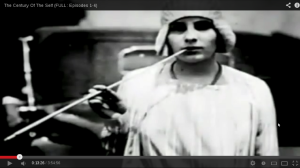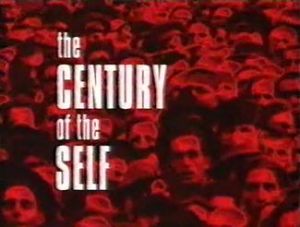To my knowledge, filmmakers like Adam Curtis simply don’t exist in America. He’s English, a documentarian for the BBC, which, in terms of American institutions, makes him something like their version of that PBS master, Ken Burns. Now, having never been patient enough (bored enough?) to sit all the way through one of Burns’s documentaries, the two may turn out to more similar than I suspect, but I don’t think so. The closest American equivalent I could come up with was Errol Morris, though Alex Gibney was a runner-up, and the Morris similarity is itself more the matter of a spot-it-from-a-mile distinctive style than one of any real artistic affinity. But while we Americans love Morris for his ability to let subjects spin their own verbal traps, Curtis is nowhere near so laconic. He’s more of an active case-builder, usually offering voice-over commentary that tells us what to make of his archival footage. This style of filmmaking—opinionated, but not activist; personal, but in no way autobiographical—is just one signal of his remove from American norms. This, despite a choice of Americana subjects consistent enough to make Burns himself seem like a foreigner.
The Adam Curtis film I’d like to suggest as required viewing is about four hours long (four one-hour episodes, made as a miniseries for BBC Two, the public channel for brainy niche pieces), so before that discussion I’m embedding a short he did in 2011 to give some idea of the Curtis Style—an appetizer, for once about issues pertaining more to the U.K. than the U.S.A. It’s a segment titled “Paranoia,” from a BBC Four meta-news commentary program, Newswipe:
Considered strictly in terms of style, this is easy enough to characterize, or to parody. There is a counterintuitive thesis (“This is a film about how ALL of us have become Richard Nixon”), far outsize what the film’s time constraints could reasonably support, followed by a re-framing of familiar issues in quintessentially Curtisian terms. The idea that the tyranny of “elitism” has been replaced by the more subtle tyranny of market forces has been well explored in Curtis’s longer works (it’s the main subject of The Trap: What Happened to Our Dream of Freedom), as has the idea that the past thirty years have fundamentally shifted the relationship of the self to society (see below). The main thing to note here, before moving on, is the way that various disjunctions between sound and image, or between familiar found images and their unfamiliarly assigned meanings, are repurposed for the specific rhetorical purposes of the film. After a thumbnail sketch of Roy Jenkins, who in this short is used to represent Britain’s old political order—elitist but still with the country’s best interests at heart—the film goes from cheezy horror film music (listen behind the million-Nixon zoom out) to a party track (behind the images of investigative journalists, images that we’re used to having played straight) to conspiracy stingers (“there really were hidden conspiracies”), all in short order. This is the documentary at its most essayistic, where every sound and image is used to bolster a particular POV.
If I weren’t so sympathetic to the claims being presented, I would probably hate this. But I am sympathetic, and in the case of The Century of the Self, the movie is long enough to give its assertions the background and incident they deserve. It presents a vision of the remodeled modern self that stretches from Sigmund Freud to Bill Clinton—and, in doing so, manages to become the most incisive critique of consumer culture I’ve seen on film.
This is television, so it can’t afford to lose our attention. Each episode opens with its own elevator pitch: “This series is about how those in power have used Freud’s theories to try and control the dangerous crowd in an age of mass democracy.” It’s a good line, and it’s most true of the first episode, “Happiness Machines,” which follows the quest of Freud’s nephew, Edward Bernays, in his transition from wartime propaganda specialist to peacetime PR-man. Which is itself an incredible understatement. Bernays invented public relations, insofar as it’s understood today—making him, at least for a while, not a PR-man, but the PR-man, an inventor of his own category of being. One film clip shows an ancient Bernays as a David Letterman guest, where Letterman asks Dr. Bernays what kind of doctor we’re dealing with here. “What we’re dealing with really,” Bernays replies, “is the concept that people will believe me more if you call me doctor.”
The Letterman audience applauds; they’re residents of the world Bernays created. But “Happiness Machines” reminds us that the world of the early 20th century was a very different place, a place where it wasn’t a natural assumption that people could be easily convinced to buy things they did not need. For that, the world needed Bernays. The world Bernays was born to was one where advertisements (the film showcases several) were more or less factual and focused on why a particular object would make your life a little easier if you purchased it. After WW1 experience building Woodrow Wilson into a hero and observing the adoring French crowds whose contact with Wilson was limited to the propaganda he had helped to create, though, Bernays came to realize that the techniques he had used to inflate Wilson’s image could just as easily be applied to inflate movie stars or cigarettes.
Perhaps the film’s most striking anecdote, in fact, describes how Bernays linked cigarettes to political motives so women might find them more attractive. After consulting a psychoanalyst and being told that the cigarette—longer than it is wide, after all—unconsciously evoked the penis, Bernays told his clients that women would be more likely to smoke if cigarettes could be linked to feminine power, as opposed to their “natural” linkage to male dominance. His solution: after alerting the media (free publicity!), he had a group of paid debutantes pose as suffragettes and light up “torches of freedom” during NYC’s Easter Sunday Parade. Within a year, the number of women smokers had increased by over 100%.
 A brave suffragette sucks her torch of freedom.
A brave suffragette sucks her torch of freedom.
“The Engineering of Consent,” the second film in the series, delves into the social and political implications of Bernays’s enormous discovery. The practical effects of possible manipulation might have seemed benign enough—in the wake of his early success, Bernays invented product placement and experimented with cross-platform pollination—but the philosophical implications, for some, were much darker. Sigmund Freud, for one, wasn’t out to sell cigarettes, but was disturbed by the primitive human urges that the world wars seemed to suggest. (Nephew Eddie, meanwhile, prepared America for his uncle’s coming with a publicity campaign that included excerpting Uncle Sigmund’s work in Cosmopolitan.) Freud’s daughter, Anna, would champion psychoanalysis as the solution for keeping these urges in check, effectively advocating societal conformity as the paradoxical necessity of a philosophy that had at its core the view that deviant, irrational urges were a ubiquitous feature of human nature.
Engineered social conformity had two forms, though—both of which would later be popularly viewed as insidious intrusions into the natural self. The first of these, Anna’s program, was repressive on the personal level. Having gone through analysis by her father once he found her masturbating, Anna Freud may not herself have had the best simulacrum of a normal family life, but that didn’t stop her from advocating the nuclear family as the epitome of the healthy individual’s relationship to society. One of Anna’s followers, the Los Angeles therapist Dr. Ralph Greenson, went so far as to use his own family as a model for his clientèle of disturbed movie stars, moving Marilyn Monroe into a house next to his so he might serve as her surrogate father figure.
This personal engineering, however, was very slight compared to the large-scale societal engineering being attempted. Ernest Dichter, by inventing the focus group, carried forward the original Bernays insight by using interviews and role-playing to determine what consumers really wanted. And though his conclusions, coldly described, might’ve sounded like bullshit (are you sure the reason women wouldn’t use instant cake-mix, upon its introduction to supermarkets, was that the saved labor evoked sense of guilt at their sloth? that the way to fix this was to have them add an egg, thus allowing the cake to double as an unconscious gift of femininity to their husbands?), it’s hard to argue with success (so…it turned out that women really did buy more cake mix if they had to add an egg [insert confused face here]). Bernays, too, was hard at work, except his work had branched out to include the government. In his most infamous coup—literally a coup, in this case—Bernays, under contract of the United Fruit Company, planned a propaganda campaign that spuriously linked the land reform efforts of Guatemala’s then-leaders to the Soviet Menace, a campaign that directly influenced the CIA to support a revolution. All for the commercial advantage of American bananas. In such campaigns, Bernays, believing that people could not be trusted to make good decisions without emotional guidance, worked deliberately to foster the confusion of capitalism with democracy that we still experience today.
 The housewife contemplates her feminine gift.
The housewife contemplates her feminine gift.
Of course, cons of this magnitude couldn’t stay secret forever. The third film, “There is a Policeman Inside All Our Heads: He Must Be Destroyed,” tracks the general disillusionment these cover-ups engendered, complete with its pat symbols of personal and public malaise (respectively, Marilyn’s suicide—attempts at normalcy are no escape—and the Watergate/Vietnam complex—and social action won’t help, either). In retrospect, it seems inevitable that the rule of psychoanalysts who worked to align people’s desires more closely with the structure of society would be replaced by a new order, ready to advocate for a realignment of society to more closely match the structure of human desires. We see how Sigmund Freud, his Mosaic aspect telegraphing a stern disgust, was symbolically replaced by Wilhem Reich, prophet of the orgasm, whose sexy orgone guns (he claimed) could threaten the clouds into rain. Rather than working to repress the self, members of the Human Potential Movement joined at the Esalen Institute for encounter sessions, where participants were assured that many of the world’s problems could be solved if only they could just express themselves more fully.
Except the unintended consequences of this hard leftward swing were nearly as dramatic as the consequences of Psychoanalysis 1.0. We’re shown the interviews of a group of nuns who were encouraged, as an experiment, to express what their true feelings. The result: apart from the few who remained as a radical lesbian contingency, the rest simply quit being nuns. Such disorienting outcomes raised a serious question. Could society survive the elevation of desire as king? The short-term answer, at least in practice, was another question: Who cares? The quest for one’s true self wouldn’t be stopped by philosophical quibbles. In the guise of EST Seminars (famously chronicled by Tom Wolfe in his great essay, “The ‘Me’ Decade and the Third Great Awakening”), the quest itself become a commercial product. Curtis includes footage of these supine pilgrims in giant hotel conference rooms, kicking, squealing, flailing—struggling mightily to achieve a “mass-produced nonconformity.”
 Freedom fighters of the 1970s, encountering themselves.
Freedom fighters of the 1970s, encountering themselves.
This ostensible shattering of the old psychoanalytic ideal, however, brought with it an ironic return to the territory of Edward Bernays, the series’s Lucifer incarnate. For if desires could now be submitted to without shame, wasn’t this exactly the sort of thing a trained marketer might best exploit? Researchers from the Stanford University spinoff SRI International were some of the first to realize the business potential of this shift. Their “Values, Attitudes, and Lifestyles” survey was able, with a detailed series of personal questions, to pinpoint the desires of the various new types of consumers that the social shifts had birthed. One type, an ad hoc addition based on the collected data, was the “inner directeds,” those for whom the demands of society were less important than the requirements of their fundamental selves. But no matter—whatever manner of existence a person (or, in the language of the times, a consumer) might inhabit, there would henceforth be products designed specifically for their desires. In the words of Stew Albert, co-founder of the Yippies, “What capitalism managed to do that was brilliant was to actually create products that people like me would be interested in. […] Capitalism developed a whole industry at developing products that evoke a larger sense of self, that seemed to agree with us that the self was infinite, that you could be anything that you wanted to be.” With this cornucopia of choice, it was hard not to concede that when business won, we consumers won, too.
But did anything lose? “Eight People Sipping Wine in Kettering,” the fourth and final episode, provides a curt response: politics lost. Curtis argues that when people started to self-identify primarily as “consumers” (a term evocative of irrational preference), rather than “citizens” (a term that suggests rational participation), this fundamentally altered their expectations of government. The “inner directeds,” to the surprise of the SRI team, were supporters of Regan and Thatcher—those politicians who “[made] the denial of compassion respectable.” Just as these prototypical Last Men expected products whose primary purpose was to serve only them, so too did they view such civic transactions as tax in businesslike terms, as a payment for services rendered to them alone.
These shifting attitudes were teased out by political focus groups. This development, now familiar enough to surprise that it was unused until the early 1990s, is told primarily through the trials of Bill Clinton, the first politician to allow such information to shape his policy positions. The film displays Clinton as a flawed crusader, a man whose good intentions were stymied by political realities at every turn. (It bears reminder that this portrait, though less positive than the hagiography routinely presented by nostalgic Americans, seems gentle when compared to the vitriol of Curtis’s fellow Briton, the late Christopher Hitchens.) During Clinton’s first campaign, polls indicated that he would lose to George Bush, Sr., if, as originally planned, he were to raise taxes, so the ever-canny Clinton simply changed course and promised voters that he would cut taxes. Upon taking office, though, he learned that budget shortages were more serious than he’d anticipated, and he couldn’t deliver these tax breaks—a failure that conservatives like Newt Gingrich were able to leverage into huge gains during midterm elections two years later. The backlash led a panicked Clinton into the arms of the ruthless political strategist Dick Morris, whose Machiavellian—Bernaysian?—advice Clinton followed to a T.
Morris realized that Clinton’s main focus, if he wanted to be reelected, would have to be on swing voters, who Clinton pursued with a single-minded focus. When polls showed that the hunting and fishing crowd might have some voters who could be swayed, for instance, Morris arranged a photo-op for Clinton the Hunter—non-sporting past be damned. No potential advantage, from V-chips to school-bus cameras, could be left unexploited. The endgame of this pursuit, just a few months before his 1996 victory, was the Personal Responsibility and Work Opportunity Act, which in one fell swoop dismantled the safeguards of the old welfare state—an exact reversal of his 1992 platforms, modified to sway the will of the nation’s few politically undecided.
The film ends with an appeal that’s surprising in its directness. Curtis claims that what Clinton began in politics has degenerated into a sort of international vicious circle, wherein politicians, refusing to take principled stands, have their positions dictated directly from voters, that lot of varied and conflicting voices, who in turn look to politicians for leadership, who turn to voters, who turn to politicians…and round the circle goes. We’re shown slo-mo shots of Tony Blair, the symbol of this vacuity, gleefully heading a volleyball. The final word goes to Robert Reich, Clinton’s disappointed Secretary of Labor, who doesn’t mince words: “Politics must be more than that. Politics and leadership are about engaging the public in a rational discussion and deliberation about what is best and treating people with respect in terms of their rational abilities to debate what is best. If it’s not that, if it is Freudian, if it is basically a matter of appealing to the same basic unconscious feelings that business appeals to, then why not let business do it? Business can do it better. Business knows how to do it. Business, after all, is in the business of responding to those feelings.”
Adam Curtis, on the other hand, is a public filmmaker, and few have expressed the sweep of history better than he has. No film in the last year has influenced me more than The Century of the Self.
Note: The embedded video above has all four parts of The Century of the Self crammed together. Unless you’re blessed with a teflon butt, though, it’s probably best not to watch the whole thing at once. To ease the difficulty of finding where you left off for a stretch break, I’ve recorded here the times when each of subsequent chapter beings: Part 1, “Happiness Machines”—0:00; Part 2, “The Engineering of Consent”—58:33; Part 3, “There is a Policeman Inside All Our Heads: He Must Be Destroyed”—1:57:33; Part 4, “Eight People Sipping Wine in Kettering”—2:54:56. In other news, if you’re the sort who likes to Google along as you watch documentaries, I also found a full transcript that may be of use.


